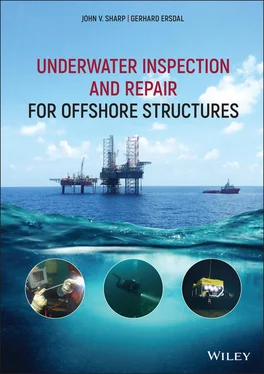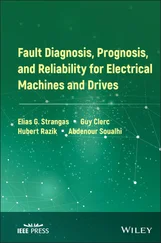Penetrations; these are areas of discontinuity and are therefore prone to water ingress and spalling at the steel to concrete interface. Any penetrations added to the structure during the operational phase are particularly susceptible to leakage resulting from difficulties in achieving high‐quality concrete in the immediate vicinity of the added penetration. ISO 19903 (ISO 2019b) states that all penetrations in the splash and submerged zones require frequent inspections (but not specified).
Steel transition ring to concrete interface; this interface is the main load transfer point between the concrete towers and steel topsides. ISO 19903 (ISO 2019b) recommends that the steel transition ring should preferably be examined annually. The examination should include the load transfer mechanism (flexible joints, rubber bearings, bolts and cover) and the associated ring beam. In addition, the concrete interface should be inspected for evidence of overstress and corrosion of embedded reinforcing steel. Corrosion‐potential surveys can be used to detect ongoing corrosion that is not visible by visual inspection alone.
Debris; it can cause structural damage through impact, abrasion or by accelerating the depletion of cathodic protection systems. It can also limit the ability to inspect various parts of the structure (e.g. tops of storage cells). Drill cuttings can build up on the cell tops and/or against the side of the structure and should be assessed for lateral pressures exerted by the cuttings, and whether they cause an obstruction to inspection. As a result of this assessment the removal of drill cuttings needs to be assessed accordingly.
Scour; this is the loss of foundation‐supporting soil material and can be induced by current acceleration round the base of the structure or by “pumping” effects caused by wave‐induced dynamic rocking motion. It can lead to partial loss of base support and unfavourable redistribution of actions. GVI is the recommended method.
Drawdown (differential hydrostatic pressure); a level of drawdown in many concrete structures is necessary for structural integrity. Structural damage or equipment failure can lead to ingress of water and loss of hydrostatic differential pressure. Special inspection may be required if loss of drawdown is detected.
Temperature of oil sent to storage; the storage cells are designed for a maximum temperature differential. In cases where differential temperatures have exceeded these design limits, special inspections may be required.
Sulphate‐reducing bacteria (SRB); these can occur in anaerobic conditions where organic material is present (such as hydrocarbons). The bacteria produce H2S (hydrogen sulphide) as their natural waste which could cause a lowering of pH value of the cement paste in the concrete. Favourable conditions for SRB growth can be present in unaerated water in, for example, the water‐filled portion of shafts and cells. An acidic environment can cause concrete softening and corrosion of reinforcement. However, it is recognised that an inspection of a concrete surface likely to be affected by SRB activity is difficult to undertake. Some guidance can be obtained by adequate monitoring of SRB activity and pH levels (HSE 1990).
Post‐tensioning; the tendons are usually contained within ducts which are grouted. Post‐tensioning anchorage zones are commonly areas of complex stress patterns. Because of this, considerable additional reinforcement steel is used to control cracking. Anchorages for the post‐tensioning tendons are generally terminated in prestressing pockets in the structure, which are also vulnerable. Inspection of tendons is, however, very difficult using conventional inspection techniques. In many cases, the reinforcing steel is very congested and this condition can lead to poor compaction of concrete immediately adjacent to the anchorage. The recess is fully grouted after tensioning. These conditions expose the critical tendon anchors to the marine environment, causing corrosion of the anchor and additional spalling and delamination of concrete and grout in the anchorage zone. Regular visual inspection of the anchorages is recommended.
Experience has shown that the anchorage zones are vulnerable to distress in the form of localized cracking and spalling of grouted anchorage pockets. Where evidence exists for this type of damage, ISO 19903 (ISO 2019b) recommends a more detailed visual inspection supplemented by impact sounding for delamination. The visual inspection should focus on corrosion staining, cracking and large accumulations of efflorescence deposits.
Partial loss of prestress is generally recognised as leading to local concrete cracking resulting from redistribution of stress. This should be investigated upon discovery. In addition, design documents should be reviewed by the inspection team to establish the arrangement and distribution of cracking that could be expected to result from partial loss of prestress.
Durability of concrete and the corrosion protection system are addressed in terms of inspection and focus on:
Concrete: factors that may change with time and may need to be surveyed regularly, such as chloride profiles, chemical attacks, abrasion depth, freeze and thaw deterioration and sulphate attack in petroleum storage areas.
Corrosion protection: Periodic examination with measurements should be carried out to verify that the cathodic protection system is functioning within its design parameters and to establish the extent of any material depletion of the anodes. Cathodic protection is also provided for the protection of the reinforcing steel, which is important for the structural integrity of the concrete. In this respect the level of adequate potential should be monitored. In general examination shall be concentrated in areas with high or cyclic stress utilization, which need to be monitored and checked against the design basis. Heavy unexpected usage of anodes should be investigated.
Examination of any coatings and linings is normally performed by visual inspection to determine the need for repairs. A close visual examination will also disclose any areas where degradation of coatings has allowed corrosion to develop to a degree requiring repair or replacement of structural components.
It is noted in ISO 19903 (ISO 2019b) that several techniques have been developed for the detection of corrosion in the reinforcement in land‐based structures. These are mainly based on electro‐potential mapping, for which there is an ASTM standard (ASTM 2015). These techniques are useful for detecting potential corrosion in and above the splash zone but have limited application under water because of the low resistance of sea water. ISO 19903 (ISO 2019b) also notes that it has been established that under many circumstances underwater corrosion of the reinforcement does not lead to spalling or rust staining. The corrosion products are of a different form and can be washed away from cracks and hence leave no evidence on the surface of the concrete (see Section 3.5). However, when the reinforcement is adequately cathodically protected, any corrosion should be prevented. In cases where cathodic protection of the reinforcement is limited, the absence of spalling and rust staining at cracks in the concrete cover should not to be taken as evidence for no corrosion.
2.5.3 Department of Energy Guidance Notes
The “Survey” section of the fourth edition Guidance Notes (Department of Energy 1990) focussed mainly on steel structures with regard to the requirements for re‐certification. At the time of preparing the fourth edition Guidance Notes, concrete structures were relatively new and a comment was made that experience to date had shown little requirement for maintenance and repair. However, specific mention was made of the lower elements of a GBS‐type structure, which were only likely to suffer significant damage if erosion or uneven settlement had taken place. It was noted that many units of this type have built‐in instruments to record the state of the foundations. With regard to corrosion of the steel reinforcement, it was noted that this is less likely in permanently submerged areas than in the splash zone. Hence, if the splash zone was found to be in good condition, then only a limited number of checks needed to be made at lower levels, except where there were sudden changes of section or high stress concentrations.
Читать дальше












